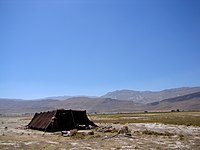
Photo from wikipedia
Economic, policy, and climate changes have profoundly influenced pastoral social-ecological systems on the Tibetan Plateau. Climate change is believed to be leading to increasing extreme weather conditions such as snow… Click to show full abstract
Economic, policy, and climate changes have profoundly influenced pastoral social-ecological systems on the Tibetan Plateau. Climate change is believed to be leading to increasing extreme weather conditions such as snow disasters and droughts, putting a strain on the rangeland resources herders must have to increase income. Market-based economic reforms and interrelated development policies such as the Rangeland Household Contract Policy, the Ecological Construction Project, and herder settlement Initiatives have increased integration of pastoral regions into modern markets with promotion of tourism, expanded livestock markets, and marketing opportunities for rangeland resources. Although allocating common rangelands to households is the foundation of current rangeland management strategies to achieve these goals, it removes important technologies for coping with high variability in rangeland forage production from the traditional rangeland management portfolio on the Tibetan Plateau. These include shared risk, shared labor, seasonal and yearly herd mobility, and access to diverse areas of rangelands and multiple water sources. Field study of two villages in Guinan County of Qinghai Province, and Ruoergai County of Sichuan Province from 2011 to 2014 found that the villages responded to externally driven policy, economic, and climate changes with an innovative locally adapted quota-based grazing management system that preserves valuable management technologies, conserves rangeland resources, and provides individual opportunities for financial gain. In this way the village social-ecological system has exhibited considerable resiliency, maintaining a form of community governance that functions to manage the rangelands, improve well-being as indicated by livestock productivity, and, according to local perceptions, maintain rangeland condition. The community-based grazing quota system devised by the villages occupies a middle ground between common and individual models for resource use because it focuses more on how to equitably distribute services and utilities from rangelands, instead of how to distribute rangelands.
Journal Title: Ecology and Society
Year Published: 2018
Link to full text (if available)
Share on Social Media: Sign Up to like & get
recommendations!